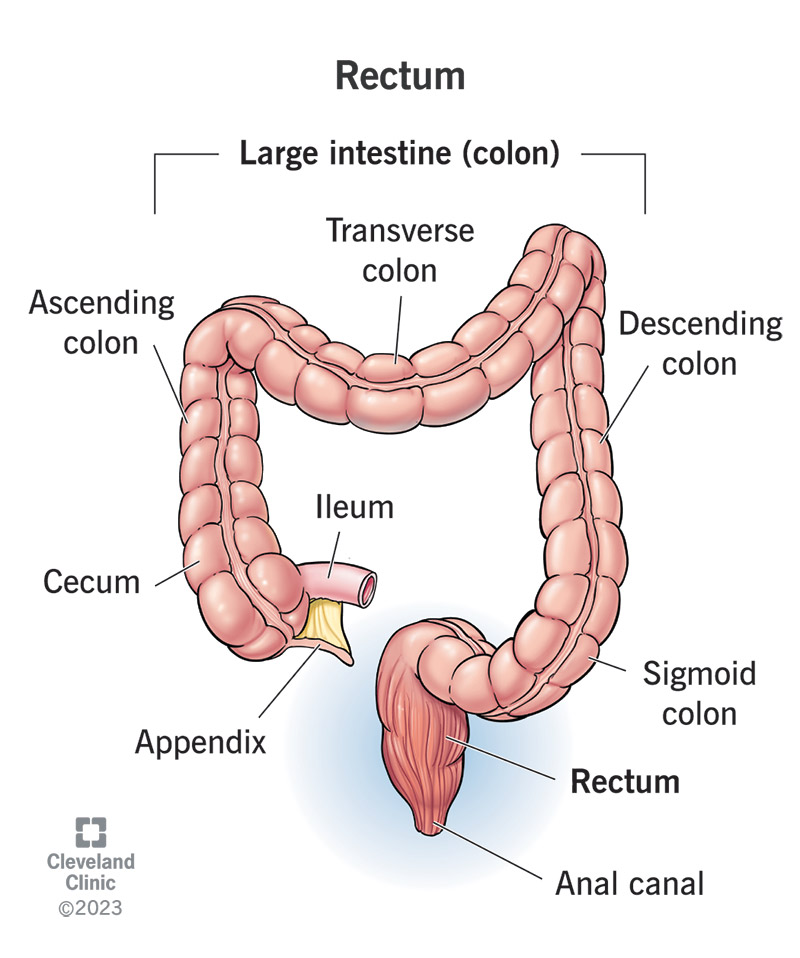Your rectum is at the end of your colon and on the other side of your anal canal. This is where your poop collects just before it’s ready to come out. Your rectum absorbs the excess water and holds it until it’s full, when nerves trigger the urge to defecate.
Advertisement
Cleveland Clinic is a non-profit academic medical center. Advertising on our site helps support our mission. We do not endorse non-Cleveland Clinic products or services. Policy

Your rectum is at the end of your large intestine, a long, continuous tube that includes your colon, rectum and anus. Your rectum makes up the last 6 inches or so, just before it turns into the anal canal. This is the last stop on your food’s journey through your gastrointestinal (GI) tract before it exits. As food waste passes from your colon into your rectum, it collects there until nerves trigger the urge to poop.
Advertisement
Cleveland Clinic is a non-profit academic medical center. Advertising on our site helps support our mission. We do not endorse non-Cleveland Clinic products or services. Policy
Your rectum continues from your colon and is made of the same stuff: layers of muscles and tissues, with glands on the inside that secrete and absorb. Your colon is much longer, and food traveling through your colon is still in the process of digestion. By the time it reaches your rectum, it’s been reduced to solid waste. Your rectum holds the waste and absorbs the remaining water until it’s time to release it.
Your anal canal continues from your rectum and makes up the last few centimeters of your large intestine. The anus contains important muscles (anal sphincters) that control your bowel movements.
The primary function of the rectum is to collect and hold your poop until it’s time to release it. Your rectum relaxes and stretches to accommodate the waste as it gradually comes in from your colon. While holding it, your rectum absorbs the remaining water and electrolytes and further solidifies the waste. It secretes mucus to help it pass through smoothly. When it’s full, nerves trigger the urge to poop.
Your large intestine surrounds your small intestine, lying loosely around the edges of your abdominal cavity. Your rectum, at the end of it, curls under your abdominal organs, toward your anus. It exists in the pelvic cavity between your abdomen and pelvis floor muscles. The top connects to your sigmoid colon and the bottom connects to your anus.
Advertisement
It averages between 10 and 15 centimeters, which is about 5 or 6 inches long. When its muscles activate to move waste through, it can contract and shorten, like a slinky. Like the rest of the large intestine, it’s about 3 inches wide, which makes it about half as wide as it is long. But it also stretches wider than the rest of the intestine to accommodate more waste, acting as a reservoir.
The rectum has a slight “S” shape, with two bends in it. The one near the top (sacral flexure) follows the curve of your spine, while the one near the bottom (anorectal flexure) marks the transition from rectum to anus. These bends help control continence (holding your poop in). The rectum also has segments, like a worm, which are separated by horizontal folds in the inner lining called the valves of Houston.
The three or four chambers of the rectum help to control the movement of contents through it. The last chamber, called the rectal ampulla, is the final reservoir for poop before it comes out. When this chamber fills, nerve fibers that detect stretch in the rectal wall (stretch receptors) communicate to your central nervous system that it’s time to defecate. Increasing pressure will make it increasingly hard to hold it in.
Rectal disorders can affect the inside lining, muscles or nerves of the rectum, causing pain and interfering with its function. Common conditions include:
Advertisement
You might want to see a healthcare provider about your rectal health if you notice:
Medical tests to examine the rectum include:
Advertisement
Not all rectal conditions are preventable, but you can reduce your risk of certain conditions by following these basic health guidelines:
Your rectum is an important bridge between your digestive process and the defecation process. Your colon at one end and your anus at the other end may affect, or be affected by, your rectal health. Difficulties with your rectum can cause significant discomfort as well as embarrassment, but it’s important to get the help you need. A gastroenterologist or proctologist can help diagnose and treat rectal conditions.
Advertisement
If you have issues with your digestive system, you need a team of experts you can trust. Our gastroenterology specialists at Cleveland Clinic can help.

Last reviewed on 03/03/2023.
Learn more about the Health Library and our editorial process.